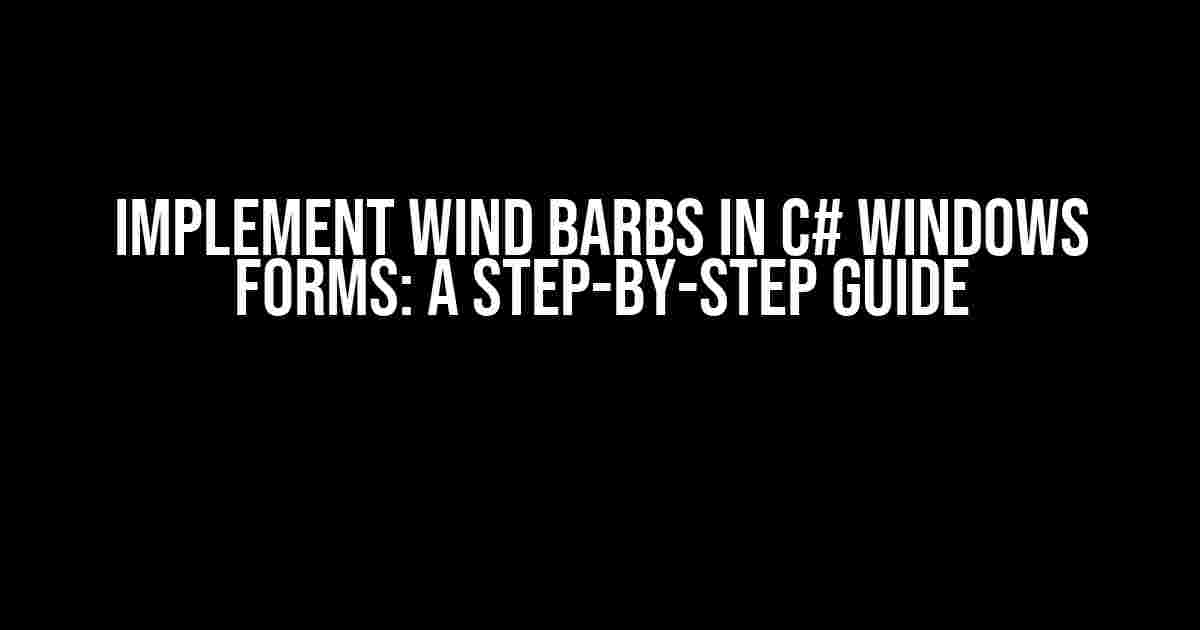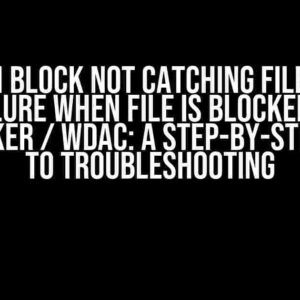Are you tired of bland and uninformative weather visualizations? Do you want to take your C# Windows Forms application to the next level by incorporating wind barbs? Look no further! In this comprehensive guide, we’ll walk you through the process of implementing wind barbs in C# Windows Forms, covering the basics, the code, and the implementation.
What are Wind Barbs?
Before we dive into the implementation, let’s quickly cover what wind barbs are and why they’re important. Wind barbs are graphical representations of wind direction and speed, providing a concise and intuitive way to visualize weather data. They typically consist of a shaft with a arrowhead at the end, pointing towards the direction the wind is coming from. The length and thickness of the shaft indicate the wind speed.
Why Use Wind Barbs in C# Windows Forms?
There are several reasons why you might want to implement wind barbs in your C# Windows Forms application:
- Enhanced Visualization**: Wind barbs provide a clear and concise way to visualize wind data, making it easier for users to understand and interpret weather information.
- Improved User Experience**: By incorporating wind barbs, you can create a more engaging and interactive user experience, setting your application apart from others.
- Increased Accuracy**: Wind barbs can help users accurately determine wind direction and speed, making it easier to make informed decisions.
Required Tools and Libraries
To implement wind barbs in C# Windows Forms, you’ll need the following tools and libraries:
- Visual Studio 2019 or later**: A IDE for developing C# Windows Forms applications.
- .NET Framework 4.7.2 or later**: A set of libraries and APIs for building C# applications.
- System.Drawing**: A library for working with graphics and drawing in C#.
Step 1: Setting Up the Project
Let’s start by creating a new C# Windows Forms project in Visual Studio:
- Open Visual Studio and create a new project by selecting “File” > “New” > “Project…”.
- In the “New Project” dialog, select “Windows Forms App (.NET Framework)” and give your project a name (e.g., “WindBarbsApp”).
- Click “OK” to create the project.
Step 2: Creating the Wind Barb Class
Next, let’s create a new class to represent our wind barb:
using System.Drawing;
public class WindBarb
{
public float WindSpeed { get; set; }
public float WindDirection { get; set; }
public Point Location { get; set; }
public WindBarb(float windSpeed, float windDirection, Point location)
{
WindSpeed = windSpeed;
WindDirection = windDirection;
Location = location;
}
}
This class has three properties: WindSpeed, WindDirection, and Location, which will be used to store the wind speed, direction, and location of our wind barb.
Step 3: Drawing the Wind Barb
Now, let’s create a method to draw our wind barb using the System.Drawing library:
using System.Drawing;
public class WindBarb
{
// ...
public void DrawWindBarb(Graphics g)
{
using (Pen pen = new Pen(Color.Black, 2))
{
// Calculate the shaft length based on wind speed
float shaftLength = WindSpeed * 10;
// Calculate the arrowhead angle based on wind direction
float arrowheadAngle = WindDirection * (float)Math.PI / 180;
// Draw the shaft
g.DrawLine(pen, Location.X, Location.Y, Location.X + (float)Math.Sin(arrowheadAngle) * shaftLength, Location.Y - (float)Math.Cos(arrowheadAngle) * shaftLength);
// Draw the arrowhead
using (Brush brush = new SolidBrush(Color.Black))
{
float arrowheadSize = 10;
float arrowheadX = Location.X + (float)Math.Sin(arrowheadAngle) * (shaftLength - arrowheadSize);
float arrowheadY = Location.Y - (float)Math.Cos(arrowheadAngle) * (shaftLength - arrowheadSize);
g.FillPolygon(brush, new Point[] {
new Point(arrowheadX, arrowheadY),
new Point(arrowheadX + (float)Math.Sin(arrowheadAngle + Math.PI / 3) * arrowheadSize, arrowheadY - (float)Math.Cos(arrowheadAngle + Math.PI / 3) * arrowheadSize),
new Point(arrowheadX + (float)Math.Sin(arrowheadAngle - Math.PI / 3) * arrowheadSize, arrowheadY - (float)Math.Cos(arrowheadAngle - Math.PI / 3) * arrowheadSize)
});
}
}
}
}
This method uses the Graphics class to draw the wind barb, taking into account the wind speed, direction, and location. The shaft is drawn using the DrawLine method, and the arrowhead is drawn using the FillPolygon method.
Step 4: Implementing the Wind Barb in the Form
Now, let’s add a WindBarb object to our form and implement the drawing logic:
using System.Windows.Forms;
public partial class Form1 : Form
{
private WindBarb windBarb;
public Form1()
{
InitializeComponent();
windBarb = new WindBarb(10, 45, new Point(100, 100));
}
private void Form1_Paint(object sender, PaintEventArgs e)
{
windBarb.DrawWindBarb(e.Graphics);
}
}
In this example, we create a new WindBarb object in the form’s constructor, passing in the wind speed, direction, and location. In the Form1_Paint event handler, we call the DrawWindBarb method, passing in the Graphics object.
Step 5: Running the Application
That’s it! You can now run the application and see the wind barb in action:
 |
In this example, the wind barb is drawn at the specified location, with the shaft length and arrowhead direction reflecting the wind speed and direction.
Conclusion
In this article, we’ve covered the steps to implement wind barbs in C# Windows Forms. By following this guide, you can now add wind barbs to your own applications, enhancing the visualization and user experience. Remember to adjust the wind speed, direction, and location to suit your specific needs.
Happy coding!
Frequently Asked Question
Get ready to harness the power of wind barbs in C# Windows Forms with these frequently asked questions!
Q1: What is a wind barb, and why do I need it in my C# Windows Forms application?
A wind barb is a graphical representation of wind direction and speed, often used in meteorological applications. You need it in your C# Windows Forms application to visualize wind patterns, making it easier to analyze and understand weather data. By implementing wind barbs, you can create interactive and informative dashboards that help users make informed decisions.
Q2: What is the best approach to implement wind barbs in C# Windows Forms?
The best approach is to use a combination of graphics and mathematics. You can use the Graphics class in C# to draw the wind barb components, such as the stem, flags, and pennants. Then, apply mathematical formulas to calculate the wind direction and speed, ensuring accurate and visually appealing representations.
Q3: How do I customize the appearance of wind barbs in my C# Windows Forms application?
You can customize the appearance of wind barbs by using APIs and properties provided by the Graphics class. For example, you can change the color, thickness, and style of the stem, flags, and pennants using the Pen and Brush classes. Additionally, you can use font and text properties to customize the labels and annotations.
Q4: Can I animate wind barbs in my C# Windows Forms application?
Yes, you can animate wind barbs using timers and graphics redrawing. By updating the wind data and redrawing the wind barbs at regular intervals, you can create a dynamic and interactive visualization of wind patterns. This can help users better understand wind behavior and patterns over time.
Q5: Are there any libraries or tools available to simplify the implementation of wind barbs in C# Windows Forms?
Yes, there are several libraries and tools available that can simplify the implementation of wind barbs in C# Windows Forms. For example, you can use libraries like ScottPlot, LiveCharts, or OxyPlot, which provide built-in support for wind barbs and other scientific visualizations. These libraries can save you time and effort, allowing you to focus on developing your application’s core features.





